*Please prepare a license ID and password for the license administrator.
*It is different from the service for JMAG WEB MEMBER (free membership). Please be careful.
Overview
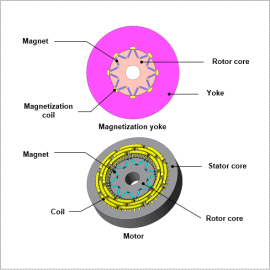
Dy-diffusion magnets can increase demagnetization resistance by distributing a high coercive force on their magnet surfaces. On the other hand, if the magnetization is incomplete, the coercive force is reduced creating areas where demagnetization is likely. Therefore, it is important to consider both the effect of Dy diffusion and the effect of incomplete magnetization.
Using finite element methods, it is possible to define the coercive force distribution and thermal demagnetization characteristics with incomplete magnetization. Motor performance at high temperatures can be evaluated using defined magnet characteristics.
In this example, the thermal demagnetization resistance of a motor is analyzed using Dy-diffusion magnets with a coercive force distribution under incomplete magnetization.
Using finite element methods, it is possible to define the coercive force distribution and thermal demagnetization characteristics with incomplete magnetization. Motor performance at high temperatures can be evaluated using defined magnet characteristics.
In this example, the thermal demagnetization resistance of a motor is analyzed using Dy-diffusion magnets with a coercive force distribution under incomplete magnetization.
Magnetization Material Determined from Demagnetization Data
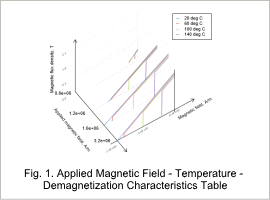
Since the demagnetization characteristics after magnetization also depend on the temperature, prepare a characteristic table based on the applied magnetic field during magnetization and the temperature to be used after magnetization. Since the applied magnetic field is not uniform in the magnet, each element has different demagnetization characteristics.
Fig. 1 shows the table of applied magnetic field-temperature-demagnetization characteristics.
Fig. 1 shows the table of applied magnetic field-temperature-demagnetization characteristics.
Dy-diffusion Magnet Coercive Force Distribution
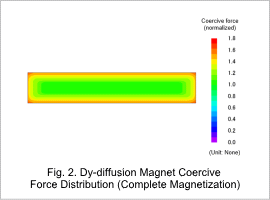
The Dy-diffusion magnet maximum coercive force is distributed inside the magnet. Fig. 2 shows the coercive force distribution (complete magnetization) of a Dy-diffusion magnet used in this case study.
During incomplete magnetization, the coercive force distribution changes vs. the applied magnetic field.
During incomplete magnetization, the coercive force distribution changes vs. the applied magnetic field.
Magnetization Distributions
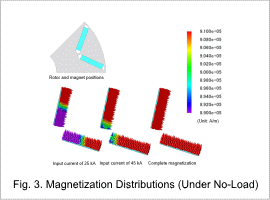
Fig. 3 shows the magnet magnetization distributions obtained by in-place magnetization at input currents of 25 kA and 45 kA. The smaller the input current, the smaller the magnet magnetization near the bridge. Incomplete magnetization results where the magnetization is small.
In addition to the effect of the magnitude of the magnetization, the Dy-diffused magnets are also affected by the coercive force distribution. Demagnetization is likely to occur where there is low coercive force and incomplete magnetization.
In addition to the effect of the magnitude of the magnetization, the Dy-diffused magnets are also affected by the coercive force distribution. Demagnetization is likely to occur where there is low coercive force and incomplete magnetization.
Torque
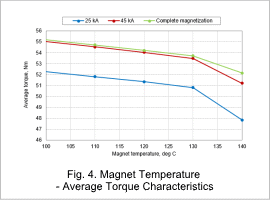
Fig. 4 shows the average torque when the magnet temperature is varied.
When the magnetization current is 25 kA, it can be seen that even at 100 deg C the torque is lower than with complete magnetization. From this it is predicted that compared with complete magnetization a decrease in the overall torque over the entire temperature range results due to the entire magnet not being sufficiently magnetized due to the effect of incomplete magnetization at the magnetization current of 25 kA.
Also, the magnetization characteristics change as the temperature rises. Even with complete magnetization, when the temperature is 130 deg C or more, the torque decreases greatly and thermal demagnetization occurs. At the magnetization current of 45 kA, the torque up to 130 deg C is almost the same as that at complete magnetization, but when 130 deg C is exceeded, the torque decreases more than at complete magnetization. This is because with incomplete magnetization there is an area where demagnetization is large, thus at high temperature there is more demagnetization than with complete magnetization. From this the average torque is reduced.
When the magnetization current is 25 kA, it can be seen that even at 100 deg C the torque is lower than with complete magnetization. From this it is predicted that compared with complete magnetization a decrease in the overall torque over the entire temperature range results due to the entire magnet not being sufficiently magnetized due to the effect of incomplete magnetization at the magnetization current of 25 kA.
Also, the magnetization characteristics change as the temperature rises. Even with complete magnetization, when the temperature is 130 deg C or more, the torque decreases greatly and thermal demagnetization occurs. At the magnetization current of 45 kA, the torque up to 130 deg C is almost the same as that at complete magnetization, but when 130 deg C is exceeded, the torque decreases more than at complete magnetization. This is because with incomplete magnetization there is an area where demagnetization is large, thus at high temperature there is more demagnetization than with complete magnetization. From this the average torque is reduced.


